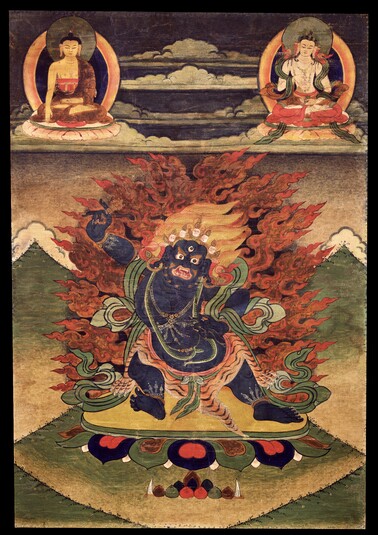
Item: Vajrapani (Bodhisattva & Buddhist Deity)
| Origin Location | Tibet |
|---|---|
| Date Range | 1800 - 1899 |
| Lineages | Buddhist |
| Size | 45.72x31.75cm (18x12.50in) |
| Material | Ground Mineral Pigment, Fine Gold Line on Cotton |
| Collection | Tibet House, New York |
| Catalogue # | Gift of Shelley & Donald Rubin |
| Painting School | Palpung / Situ |
Classification: Deity
Vajrapani (Tibetan: chag na dor je. English: Holder of the Vajra), wrathful bodhisattva, representing the power of all Buddhas.
Sanskrit: Vajrapani Tibetan: chag na dor je
Tibetan: chag na dor je
Vajrapani, dark blue in colour with one face and two hands, appears in the form of a raksha (a daemon of classical Indian mythology) with three large staring eyes, a gaping mouth with bared canine teeth and orange beard, eyebrows and hair flowing upward like flame. The body is squat, large and fleshy. Adorned with a crown of five skulls with red pendants and gold earrings, bone necklace and bracelets, anklets, and a large green snake, he wears a long green scarf and a lower garment of tiger skin tied with a green sash. With the right leg bent and the left extended above a sun disc and multi-coloured lotus Vajrapani stands in the middle of the blazing fire of pristine awareness. Placed in front as an offering, framed by two ivory elephant tusks, an assortment of wishing jewels are arranged on a plain green landscape - painted in the style of Eastern Tibet.
At the top left is a seated buddha, yellow in colour with the right hand performing the mudra of ?earth witness? and the left placed in the mudra of meditation; seated in vajra posture above a moon disc and lotus. At the right is the deity of purification, Vajrasattva, white in colour with one face and two hands holding a vajra in the right held to the heart and with the left an upturned bell in the lap. Adorned with a crown, jewel ornaments and variously coloured silk garments he sits in the vajra posture above a moon disc and lotus seat.
Vajrapani represents the power aspect of complete enlightenment, and known as Guhyapati (Tibetan: sang wa'i dag po), he is the 'Lord of Secrets' - the keeper of all the tantras of Vajrayana Buddhism. As a bodhisattva, like Manjushri and Avalokiteshvara, he dwells on the 10th bodhisattva level just prior to attaining complete buddhahood. In actuality all three were completely enlightened aeons ago and only appear, for the sake of training others, in the guise of bodhisattvas.
Vajrapani is common to all Schools of Tibetan Buddhism and has numerous forms and practices which span all sets of tantric classification and levels of complexity from a solitary aspect up to the large and complex mandalas with many deities.
Jeff Watt 7-98
Collection of Tibet House: New York (Repatriation)
Buddhist Deity: Vajrapani Main Page
